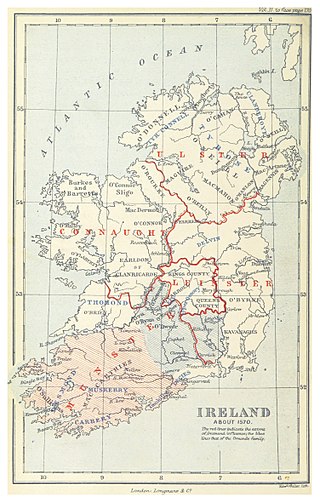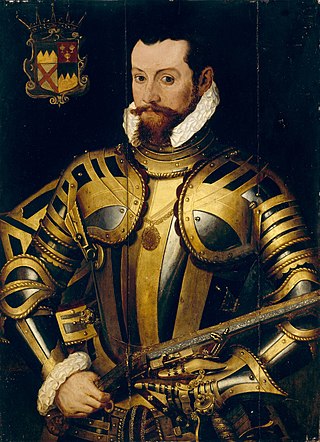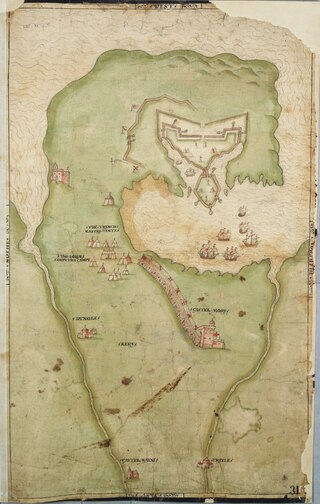Sir William Stanley, son of Sir Rowland Stanley of Hooton and Margaret Aldersy, was a member of the Stanley family, Earls of Derby. He was an officer and a recusant, who served under Elizabeth I of England and is most noted for his surrender of Deventer to the Spanish in 1587.

Earl of Desmond is a title of nobility created by the English monarch in the peerage of Ireland. The title has been created four times. It was first awarded in 1329 to Maurice FitzGerald, 4th Baron Desmond, a Hiberno-Norman lord in Southwest Ireland, and it was held by his descendants until 1583 when they rose against the English crown in the Desmond Rebellions. Following two short-lived recreations of the title in the early 1600s, the title has been held since 1628 by the Feilding family of Warwickshire, England. The current holder is Alexander Feilding, 12th Earl of Denbigh and 11th Earl of Desmond.

The Desmond Rebellions occurred in 1569–1573 and 1579–1583 in the Irish province of Munster. They were rebellions by the Earl of Desmond, the head of the FitzGerald dynasty in Munster, and his followers, the Geraldines and their allies, against the threat of the extension of the English government over the province. The rebellions were motivated primarily by the desire to maintain the independence of feudal lords from their monarch but also had an element of religious antagonism between Catholic Geraldines and the Protestant English state. They culminated in the destruction of the Desmond dynasty and the plantation or colonisation of Munster with English Protestant settlers. 'Desmond' is the Anglicisation of the Irish Deasmumhain, meaning 'South Munster'.

Thomas Butler, 10th Earl of Ormond and 3rd Earl of OssoryPC (Ire), was an influential courtier in London at the court of Elizabeth I. He was Lord Treasurer of Ireland from 1559 to his death. He fought for the crown in the Rough Wooing, the Desmond Rebellions, and Tyrone's Rebellion. He fought his rival, Gerald FitzGerald, 14th Earl of Desmond in the Battle of Affane in 1565.
Finnin MacCarthy (1560–1640), was an Irish clan chief and member of the Gaelic nobility of Ireland of the late 16th-century and the last credible claimant to the Mac Carthaig Mór title before its suppression by English authority. Mac Carthaig's involvement in the Nine Years' War (1595–1603) led to his arrest by the Crown, and he spent the last 40 years of his life in custody in London. His clan's lands were divided among his relatives and Anglo-Irish colonialists.

Gerald FitzGerald, 14th Earl of Desmond, also counted as 15th or 16th, owned large part of the Irish province of Munster. In 1565 he fought the private Battle of Affane against his neighbours, the Butlers. After this, he was for some time detained in the Tower of London. Though the First Desmond Rebellion took place in his absence, he led the Second Desmond Rebellion from 1579 to his death and was therefore called the Rebel Earl. He was attainted in 1582 and went into hiding but was hunted down and killed.

Fiach mac Aodha Ó Broin was Chief of the Name of Clann Uí Bhroin and Lord of Ranelagh during the Elizabethan wars against the Irish clans.
James fitz Maurice FitzGerald, called "fitz Maurice", was a Gaelicised Hiberno-Norman nobleman and the captain-general of Desmond while Gerald FitzGerald, 14th Earl of Desmond, was detained in England by Queen Elizabeth after the Battle of Affane in 1565.
Edmund Fitzgibbon, 11th White Knight, was an Irish nobleman of the FitzGerald dynasty, who held a Hiberno-Norman hereditary knighthood. His loyalty to Elizabeth I resulted in the capture of his kinsman, the self-declared 16th Earl of Desmond, James FitzThomas FitzGerald.

The Battle of Affane was fought in County Waterford, in south-eastern Ireland, in 1565, between the forces of the Fitzgerald Earl of Desmond and the Butler Earl of Ormond. The battle ended in the rout of the Desmond forces. It was one of the last private battles fought in Britain or Ireland.
The Second Desmond Rebellion (1579–1583) was the more widespread and bloody of the two Desmond Rebellions in Ireland launched by the FitzGerald Dynasty of Desmond in Munster against English rule. The second rebellion began in July 1579 when James FitzMaurice FitzGerald landed in Ireland with a force of Papal troops, triggering an insurrection across the south of Ireland on the part of the Desmond dynasty, their allies, and others who were dissatisfied for various reasons with English government of the country. The rebellion ended with the 1583 death of Gerald FitzGerald, 14th Earl of Desmond, and the defeat of the rebels.

The siege of Smerwick took place at Ard na Caithne in November 1580, during the Second Desmond Rebellion in Ireland. A force of between 400 and 700 Papal freelance soldiers, mostly of Spanish and Italian origin, landed at Smerwick to support the Catholic rebels. They were forced to retreat to the nearby promontory fort of Dún an Óir, where they were besieged by the English. The Papal commander parleyed and was bribed, and the defenders surrendered within a few days. The officers were spared, but the other ranks were then summarily executed on the orders of the English commander, Arthur Grey, the Lord Deputy of Ireland.
Connor O'Brien, 3rd Earl of Thomond also spelt Conor and called Groibleach, or the "long-nailed", contended with his uncle Donnell for the Chieftainship of Clan O'Brien from 1535 to 1565. He was confirmed as 3rd Earl of Thomond in 1558 by the Lord Deputy of Ireland, Thomas Radclyffe, 3rd Earl of Sussex. O'Brien intrigued with fitz Maurice in 1569 during the 1st Desmond Rebellion and fled to France. He returned and was pardoned in 1571, being restored to his lands at the end of the rebellion in 1573.

Sir William Pelham was an English soldier and Lord Justice of Ireland, which was a military and political role rather than a judicial one.

Sir Edmund Butler of Cloughgrenan, was an Irish noble and the second son of James Butler, 9th Earl of Ormond and Lady Joan Fitzgerald. He was a scion of the House of Ormond, and a rebel against the Tudors.

James fitz John FitzGerald, 13th Earl of Desmond, also counted as the 14th, ruled 22 years, the first 4 years as de facto earl until the death of James FitzGerald, de jure 12th Earl of Desmond, called Court Page, who was murdered by James fitz John's brother Maurice fitz John FitzGerald, called Totane. James fitz John FitzGerald maintained himself in power by skilful diplomacy, avoiding armed conflict and destruction. He was appointed Lord Treasurer of Ireland in 1547.
John Fitzedmund Fitzgerald was the hereditary Seneschal of Imokilly, an Irish nobleman of the originally Anglo-Welsh-Norman FitzGerald dynasty in the province of Munster.
Thomas Fitzmaurice, 16th Baron Kerry and Baron Lixnaw (1502–1590) was an Irish nobleman, politician, and peer.
The sack of Youghal was the capture of the English-held town of Youghal by Irish rebel forces under the command of the Gerald FitzGerald, the 14th Earl of Desmond on 13 November 1579 as part of the Second Desmond Rebellion. Youghal, a town in the Irish province of Munster, was controlled by the English, making it a target to Irish rebel forces during the rebellion. FitzGerald led an Irish rebel force which captured the city, massacred the English Army garrison, and sacked the town. After news of the sack became known, numerous reprisals were carried out on Catholic non-combatants throughout Ireland.

Castle Maine, also recorded as Castle Magne and Castlemaine, was a medieval castle located at what is now Castlemaine, County Kerry. The castle, built in 1215, stood on a bridge over the River Maine. A defensive structure of considerable importance in Munster, it belonged first to the Earls of Desmond and later to the English Crown. Castle Maine was besieged on several occasions, including during the Nine Years' War when the garrison resisted for thirteen months. It was destroyed in 1652 during the Cromwellian conquest of Ireland.








